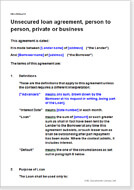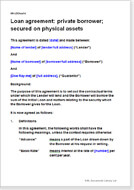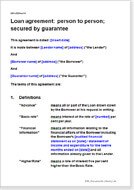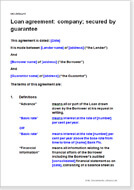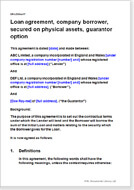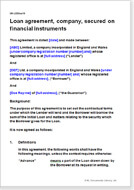What is a loan agreement?
A loan agreement (sometimes called a loan contract) is a contract between a lender and a borrower whereby the lender agrees to lend a certain amount of money to the borrower.
By making use of a loan agreement, the lender and the borrower can document their arrangement on, amongst other terms:
- purpose of the loan
- loan amount
- interest payable
- duration of the loan
- how the borrower will repay the loan (comprising of principal amount and interest payable). For example, the borrower can make monthly or quarterly payments (regular payments that go towards the principal and interest), pay the total amount on a set date before the maturity date (lump sum), or the borrower can follow a repayment schedule (regular payments or lump sum)
- security against the loan
- circumstances in which the loan becomes payable immediately
Basic elements of a simple loan agreement
A simple loan agreement is likely to state:
- Borrower: the individual receiving the loan amount and liable to pay it back.
- Lender: the individual lending loan amount to the borrower
- Principal amount: the total amount that the borrower lends
- Interest: a percentage of the borrowed amount or a fixed sum to be paid to the lender in consideration of making the loan
- Maturity date: the due date when the term of the loan expires and the borrower must have repaid the loan (the principal amount, any accrued interest and fees and expenses)
Why is it important to use a loan agreement?
If there is one contract that should always be in writing, it is a loan agreement.
Regardless of whether you are lending to or from a family member, colleague, or someone you do not know well, it cannot be emphasised enough how important it is to record the loan amount and any conditions of the loan in an agreement.
Borrowing any amount of money is a large commitment and it is important that both the lender and borrower are agreed and clear as to terms of the loan. A written agreement protects both the borrower and the lender.
If you are lending to someone you don't know well, securing the loan against assets that easily can be sold is often a good idea. If the borrower fails to repay the capital or the interest of the loan, the lender may acquire the assets submitted as security and sell them off to realise the loan amount.
If you are lending to someone in your family or a friend you can use the unsecured loan agreement or the family members and friends loan agreement. The reason to have a loan agreement when lending to family or friends might be to keep your relationship strong rather than to be a contract you want to enforce.
Once a lender agrees and the parties sign a loan agreement, the lender cannot renege and refuse to lend the borrower the sum agreed on the terms set out in the loan agreement.
Why use our loan agreement templates?
All these loan agreement templates are drawn outside the National Consumer Credit Protection Act 2009 and do not comply with the requirements of the National Credit Code.
Whilst that makes them unsuitable for commercial lenders in the business of lending or providing credit, for private lending and personal loans they are very flexible, allowing you to make, more or less, the deal you choose.
Our loan agreement templates are strong in law, favour the lender, and cover a large range of possible transactions.
We have provided many options in most of our loan agreement templates and written them in plain English. This makes our legal documents easy to understand and edit any commercial terms according to your preference.
Suitable for all forms of private lending
Our loan contract templates can be used by any person or organisation (companies, business partnerships, and LLPs) for all forms of private lending.
Use these agreements:
- For short- or long-term lending
- Regardless of where the two parties are: Australia or abroad
- For loan amount of any size, and with repayment terms of any complexity
- When lending money to an individual, company or a business partnership,
- When borrowing money from another business
- To create a promissory note that can be recognised as an asset
Which loan agreement template should you use?
Loan agreement for use if your borrower is an individual person
For a very simple loan agreement that has no guarantor and no security, you should use the unsecured loan agreement: person to person; private or business.
For a personal loan to a member of your immediate family, a friend, or a relative, use the personal loan agreement template for lending to friends and family.
If you want to include a guarantor (which could be a life partner, parent, or a relative) to guard against non-payment, you should use the person to person loan agreement secured by guarantee.
If you are an individual or a company lender and your borrower promises and agrees to pledge his or her shares, other financial assets or intellectual property as security. Maybe he wants to borrow money to use for his company but you are only willing to lend money to him personally. In this case, you should use the loan agreement for individual borrower that is secured on financial assets.
In other cases, your borrower might be a private individual who wants to borrow money to buy a university education or stock for his business and gives security over his physical assets. In such a case, you should use the loan agreement for a private borrower secured on physical assets.
Loan agreements for use if your borrower is a limited company
If your borrower is a company, you should use a secured loan agreement. Further, you need to provide for authority to enter into the deal, promise not to change the structure or other matters related to company law. These terms are already provided in our loan agreement templates.
If the borrower is a company, you should use the loan agreement for loan to company where the directors personally guarantee repayment of the loan.
In other cases, you may want provisions for security provided by financial instruments or other intellectual property. The security should be shares or some other property that can be sold easily. In this case, you should use a loan agreement for loan to company that is secured on financial instruments.
Conversely, you may want the company borrower to secure the loan against physical assets of the company (something that is not 'fixed to the land'). For these types of loans, you should use loan agreement for company borrower that is secured on physical assets and preferably include a guarantor.
The terms in these lending agreements
Each loan agreement template is drawn for circumstances that differ slightly from the others, so the terms in each vary. But be assured -we provide extensive guidance notes with every loan contract that explain each paragraph in the contract in detail. Our loan agreement templates include, amongst others, the following terms:
Guarantors
Almost all the loan agreement templates provide for guarantors – even if the loan amount is secured against other assets as well.
In most cases, a guarantee is much more effective than other types of security because non-repayment risks a relationship and the reputation of the guarantor as well as of the borrower. Even if the borrower's credit history is impeccable, a guarantor could be brought in.
Additionally, in most situations, the lender only needs to satisfy themself that the guarantor has sufficient assets overall and passes a credit check, and therefore doesn’t have to perform detailed valuations of individual items offered as security.
We strongly advise that you insist on a guarantor when you lend to a company. The guarantor should be one or more directors of the company. Remember that a guarantee is far more effective if it includes the spouse or life partner of a director.
Guarantors should be reminded to read the entire loan agreement carefully, and not just the provisions relating to their guarantee.
Term (duration)
The time period during which the amount is lent can be any you choose. There are no legal consequences if the term is long or short: no notices, no special registrations.
We suggest that the repayment period is a specific time period, such as one year, rather than conditional on another event, such as a student loan application being accepted. The problem with a conditional event is that even if it is certain to happen, the two parties may not have the same expectations as to the timing at the outset. As obvious as it sounds, a fixed term loan is certain to meet the timing criteria to be repaid.
Interest rate
There is no limit in law on the interest rate or the total interest amount that the lender may charge. It can be whatever the two parties agree. It could be fixed for the duration, or variable from one time period to another depending on another factor (such as a bank rate). It could be reduced for prompt payment.
In our loan agreement templates we have optionally provided for a greater rate of interest if the debtor falls behind with regular repayments. That is done very carefully so as to avoid it being treated as a “penalty” - not allowed in Australian law.
Interest could be accrued and paid at the end of the term, or it could be payable in regular payments (e.g. monthly). Deferment is more common if the sum borrowed is to be spent on a project that realises a large return at the end of the term, and the principal and interest are paid together.
Loan repayment options
Our loan agreement templates provide option that the borrower repay the loan in a staggered approach.
We allow optionally for a repayment schedule to be used.
The lender is given strong protection
All our loan agreement templates provide strong protection for the person or party lending the money. This applies more to those documents where the reason for lending is a business one rather than to help family or friends. We take the simple view that since the money is not a gift, everyone expects it to be repaid.
If you are lending to someone close to you it is unlikely that you will want to bankrupt them if the borrower fails to make a repayment. However, in a business deal, remember that if the business goes down, a dispute as to entitlement is more likely to be against a liquidator or receiver than against the shareholder-director who took on the debt. That is why we make the terms of these lending agreements so strong.
Assets as security
In a secured loan, the borrower promises to put up a property or assets as collateral. So if the borrower defaults, the lender's position is secured as he can use the collateral to realise the outstanding loan amount.
Physical goods can provide sound security because the lender should be able to acquire them and sell them easily if the borrower defaults. Of course, goods that can be removed easily provide better collateral than those that require specialist equipment to move them.
In these loan agreement templates, the sum lent can be secured either by taking physical possession of the assets at the outset, or by leaving them in place and describing them in detail in the agreement. The loan agreement provides the evidence that the item is secured.
What is a Division 7A loan agreement?
A Division 7A loan agreement is one where the loan qualifies under the Income Tax Assessment Act as a loan, and not a payment of dividends to the recipient.
If the loan were instead treated under Div 7A as a dividend payment, then income tax would be assessable on it.
Division 7A prevents companies from distributing money to their shareholders and shareholders' associates under the guise of a loan, in order to avoid the person from paying income tax on that amount.
To qualify as a loan, the payment generally must either:
- be repaid before the company's lodgment day for the year in which the loan was made; or
- be made at 'arms length' in the ordinary course of business, most likely with a commercial rate of interest charged on it.
There is no specific template for a Div 7A loan. Instead, if the lender is a company and the loan is being made to a shareholder or close associate, then you should ensure that the terms and conditions of the loan are comparable to other loans that might be made by a commercial lender.
Lending to a company requires registration of the charge
If a company borrows an amount of money against security, then registration of the charge at Australian Securities and Investment Commission is required, if the lender wants to be given preference over unsecured creditors.
The Personal Property Securities Act 2009 ('PPS Act') commenced in Australia on 30 January 2012 and established a new system for the registration of security interests in personal property. Prior to personal security reforms, the charges were registered on the Australian Securities and Investment Commission ('ASIC') Register of Company Charges. Registration and the relative priority of these interests were governed by the Corporations Act 2001.
The Australian PPS Act establishes the Personal Property Securities Register ('the PPS Register'). This register is a single, national register which replaces numerous State, Territory and Commonwealth electronic and paper registers. A personal property security is where a secured party takes an interest in personal property as security for a loan or other obligation, or enters into a transaction that involves the supply of secured finance.
The PPS Act generally requires the registration of security interests in order for priority to be maximised. As a simple example, a registered security interest will have priority over an unregistered security interest despite being created after the unregistered security interest.
Note: We repeat our document templates are drawn outside the National Consumer Credit Protection Act 2009, these are not suitable for companies in the business of lending or providing credit to consumers.
Check authority to enter into a loan agreement
If either party is a company or if the loan is made intercompany, then you should check in advance whether the directors as a whole have authority to bind the company to the contract, and if they do, which directors may sign on behalf of the company.
You may need two authorised signatories (likely to be two directors or a single director plus a company secretary). For a company with a sole director, or many where a director is a majority shareholder, the signature of that one person may be sufficient.


